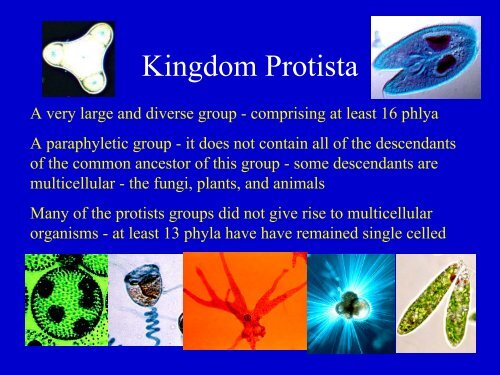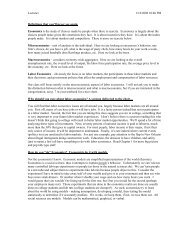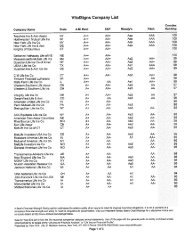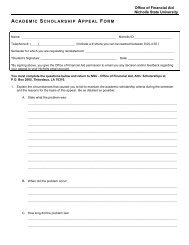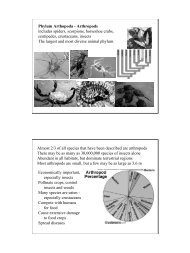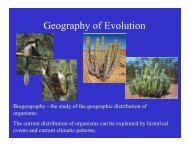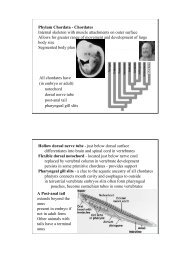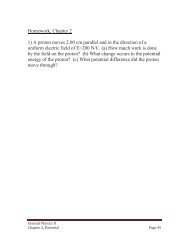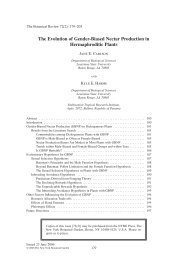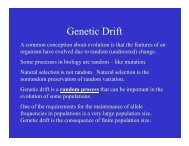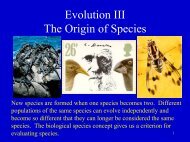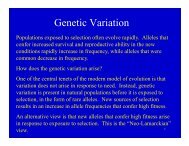Kingdom Protista
Kingdom Protista
Kingdom Protista
Create successful ePaper yourself
Turn your PDF publications into a flip-book with our unique Google optimized e-Paper software.
<strong>Kingdom</strong> <strong>Protista</strong><br />
A very large and diverse group - comprising at least 16 phlya<br />
A paraphyletic group - it does not contain all of the descendants<br />
of the common ancestor of this group - some descendants are<br />
multicellular - the fungi, plants, and animals<br />
Many of the protists groups did not give rise to multicellular<br />
organisms - at least 13 phyla have have remained single celled
Current classification is changing and likely to change greatly in<br />
the near future.
Sixteen Phyla comprise the <strong>Kingdom</strong> <strong>Protista</strong><br />
classically grouped into 5 informal groups based on mobility and<br />
nutrition - differs from evolutionary estimates of relatedness
<strong>Protista</strong>n Diversity<br />
The Cell Surface<br />
Amoebas lack a cell wall<br />
Algae and slime molds encased in strong cell walls<br />
Diatoms and Foraminiferans have shells of silica, calcium, debris<br />
Locomotor Organelles<br />
Many move by flagellar motions, or ciliary action, pseudopodial<br />
movement - many are immobile<br />
Nutrition<br />
Phototrophs and Heterotrophs (phagotrophs (ingesters) and<br />
saprobes)<br />
Reproduction<br />
Asexual reproduction by mitosis, fission, budding, spores<br />
Sex by gametic meiosis, zygotic meiosis, or sporic meiosis
The Sarcodines - all can have pseudopodia<br />
Phylum Rhizopoda - the amoebas<br />
Phylum Actinopoda - actinopods, heliozoans<br />
Phylum Foraminifera - forams
Phylum Rhizopoda - the amoebas<br />
Heterotrophic<br />
Fresh and salt water, abundant in soil, some parasitize animals<br />
Reproduction by simple mitotic fission<br />
No cell walls, flagella, sexual reproduction<br />
Locomotion via pseudopodia<br />
Pseudopodia also used for prey capture<br />
Parasitic species may form resistant cysts<br />
Entamoeba histolytica : Causes amoebic dysentery<br />
Cysts resist digestion by host<br />
Carriers exhibit no symptoms but can spread cysts<br />
Spread through fecal contamination in food or water<br />
may be dispersed by flies
Phylum Actinopodia - Actinopods -<br />
silica (glass) skeletons covering most of cell<br />
with many thin needlelike pseudopods that<br />
project through pores
Phylum Foraminifera - Forams<br />
Heterotrophic, marine organisms<br />
Possess pore-studded shells called tests<br />
tests: organic matter reinforced with inorganic<br />
usually multichambered, often spiral shaped<br />
material: often calcium carbonate, can use sand grains,<br />
echinoderm plates, sponge spicules<br />
Podia extrude through pores in test - used for swimming,<br />
gathering material for test, feeding<br />
White Cliffs of<br />
Dover - chalk<br />
formed from<br />
deposited forams
Algae and other photosynthetic protists<br />
Phylum Chlorophyta - green algae<br />
Phylum Rhodophyta - red algae<br />
Phylum Pheophyta - brown algae<br />
Phylum Chrysophyta - golden algae<br />
and diatoms<br />
Phylum Pyrrophyta - dinoflagellates<br />
Phylum Euglenophyta - euglenoids
Phylum Chlorophyta: Green Algae<br />
Ancestors of all plants were multicellular green algae<br />
green algae and plants use chlorophylls a and b, carotenoids<br />
found in aquatic and semiterrestrial habitats<br />
Unicellular and multicellular forms<br />
Chlamydomonas is a<br />
typical unicellular form<br />
biflagellated<br />
light sensitive eye-spot<br />
zygotic meiosis with<br />
zygospore resting stage
Some green algae are motile and<br />
colonial like Volvox<br />
Specialized reproductive cells give rise<br />
to new colonies within the parent<br />
colony<br />
Has zygotic meiosis and zygospores<br />
form within a parent colony.<br />
Some green algae are<br />
filamentous - like Spirogyra<br />
named for its spiral<br />
chloroplasts<br />
Sex is through conjugation<br />
of cells from + and - strains
Some green algae, like Ulva, form<br />
multicellular sheets and have sporic<br />
meiosis<br />
Except for their ploidy,<br />
the gametophytes and<br />
sporophytes are very<br />
similar
Phylum Rhodophyta - Red Algae<br />
Most common coastal seaweeds - mostly multicellular, common in<br />
warm waters<br />
Chloroplasts have Chlorophyll a and phycobilins, like cyanobacteria<br />
Absorb green, violet and blue light<br />
Grow at greater depths than other algae<br />
have sporic meiosis<br />
Completely lack flagella<br />
Body composed of interwoven filaments<br />
An ancient group of eukaryotes<br />
Economic importance<br />
Some make sulfated polysaccharides like agar and carrageenan<br />
Agar used as laboratory medium, a base for cosmetics, used in<br />
baked goods and as a temporary preservative for meat and fish<br />
Carrageenan used in paints, cosmetics and ice cream
Phylum Phaeophyta - Brown Algae<br />
Mostly multicellular and marine<br />
Conspicuous seaweeds, include kelps and Sargassum<br />
Use chlorophylls a and c (like diatoms)<br />
Photosynthetically productive - fast growing<br />
Provide food for many animals<br />
Some kelps grow up to 100 meters in length<br />
Have sporic meiosis<br />
sporophyte: large, conspicuous kelp-like form<br />
gametophyte: small, filamentous form<br />
separate male and female gametophytes
Phylum Chrysophyta - Diatoms and Golden Algae<br />
Diatoms are photosynthetic, unicellular organisms<br />
Double shells of silica - Resemble box with lid<br />
Use chlorophylls a and c, and carotenoids<br />
fossilize well - thick sediments of fossil<br />
diatoms are called “diatomaceous earth”<br />
Some move by secretions from shell<br />
Asexual reproduction separates shell halves<br />
each half produces new shell within old<br />
one - become smaller with each division<br />
Have gametic meiosis - cells are diploid<br />
and produce sperm or eggs by meiosis<br />
Golden Algae - use yellow and brown carotenoid pigments, and<br />
xanthophyll accessory pigments<br />
Unicellular, two flagella, often colonial, common in freshwater<br />
Form resistant cysts when ponds dry out in summer
Phylum Pyrrhophyta - Dinoflagellates<br />
Unicellular, photosynthetic, mostly marine, some bioluminescent<br />
Distinctive flagella and coat<br />
two flagella beat in grooves<br />
coat composed of cellulose plates<br />
Most use chlorophyll a & c and carotenoids<br />
Some are symbiotic with animals<br />
sea anemones, mollusks and corals<br />
in corals - called “zooxanthellae”,<br />
required for formation of coral reefs<br />
Some forms cause “red tide”<br />
large blooms result in red colored water<br />
release toxins that kill fish and shellfish<br />
consumption of poisoned fish can kill<br />
Reproduce primarily asexually by longitudinal cell division with<br />
nuclear mitosis - like fungi
Phylum Euglenophyta - Euglenoids<br />
Mostly fresh water organisms<br />
Group has characteristics of plants and animals<br />
Some specimens are photosynthetic<br />
use chlorophylls a and b, and carotenoids<br />
Others lack chloroplasts and are heterotrophic<br />
Some can transform from autotrophs to<br />
heterotrophs and back, depending on<br />
presence of light and food<br />
Reproduction via nuclear mitosis and cell<br />
division<br />
No sexual reproduction known
Euglena is typical<br />
Thin flexible pellicle lies within cell membrane - composed of<br />
interlocking strips of protein<br />
have two flagella - both<br />
with bases in reservoir -<br />
one is very small<br />
Contractile vacuoles collect<br />
and pump out excess<br />
water at reservoir<br />
have light sensitive stigma<br />
paramylon granules are<br />
for food storage
Heterotrophs with flagella or cilia -<br />
Phylum Sarcomastigophora - Zoomastigotes<br />
Unicellular, heterotrophic, highly variable in form<br />
Possess one to thousands of flagella<br />
Some free-living, some parasitic<br />
Some reproduce asexually only<br />
One group alternates between amoeboid and<br />
flagellated stages<br />
Some trypanosomes are human pathogens<br />
cause sleeping sickness, East Coast fever,<br />
Chagas' disease<br />
many spread by insects, such as tsetse flies<br />
Some inhabit guts of wood-eating insects<br />
have enzymes capable of digesting cellulose<br />
Choanoflagellates are similar to feeding cells of<br />
sponges and are likely ancestors of all animals
Hiker's Diarrhea:<br />
Caused by Giardia lamblia, found world-wide<br />
Occurs in water, infects wild and domesticated animals, and<br />
humans<br />
Lives in small intestine of host<br />
Spreads as cysts in feces, can survive for months in cool water<br />
May appear in city water supplies<br />
Resistant to treatment with chlorine and iodine, requires boiling<br />
water to kill
Phylum Ciliophora - The Ciliates<br />
Unicellular, heterotrophic, with many cilia<br />
Coordinated beating provides motility<br />
Outer pellicle is tough but flexible<br />
Two types of nuclei<br />
micronuclei - diploid - reserved for sex<br />
macronuclei - polyploid - for normal<br />
cellular metabolism<br />
Specialized vacuoles ingest food and contractile<br />
vacuoles regulate water balance<br />
Food enters through gullet (cytostome) and<br />
passes into vacuoles where it is digested
Asexual reproduction by transverse<br />
fission<br />
Sexual reproduction by conjugation<br />
Two different mating types<br />
exchange haploid micronuclei<br />
Macronucleus in each individual<br />
disintegrates<br />
Multiple rounds of chromosomal<br />
replications in micronuclei<br />
reconstitutes macronucleus
Phylum Apicomplexa - Sporozoans<br />
Nonmotile, spore-forming animal parasites<br />
Have an “apical complex” at one end of cell - with fibrils,<br />
microtubules, and vacuoles - used to enter host cells<br />
Have complex life cycles with<br />
sexual and asexual phases<br />
Exhibit alternation of haploid and<br />
diploid generations<br />
Fusion of gametes produces a<br />
thick-walled cyst, the oocyst<br />
Meiotic divisions in oocyst<br />
produce infective haploid<br />
spores, sporozoites
Plasmodium causes malaria<br />
Gametocytes<br />
become<br />
gametes in<br />
gut of<br />
mosquito<br />
syngamy<br />
forms zygote<br />
and oocyst<br />
meiosis in<br />
oocyst forms<br />
sporozoites
Malaria<br />
estimated that 500 million infected, 200 million humans die<br />
each year, most infected children die<br />
symptoms include chills, fever, sweating, enlarged spleen,<br />
confusion, thirst - repeating every 48 to 72 hours<br />
Victims die of anemia, kidney failure, brain damage<br />
Effects can be reduced with drugs<br />
Focus is on eradication of malaria through elimination of<br />
mosquito carriers<br />
Vaccines against malaria may be available in near future
Slime Molds<br />
Phylum Acrasiomycota - Cellular<br />
Slime Molds<br />
Phylum Myxomycota -Plasmodial<br />
Slime Molds<br />
Phylum Oomycota - water molds,<br />
rusts, mildew
Phylum Acrasiomycota - Cellular Slime Molds<br />
Once thought to be related to fungi<br />
most closely related to amoebas<br />
Common in fresh water, damp soil, rotting vegetation<br />
Usually found as free<br />
living amoebas<br />
Sometimes cells aggregate<br />
into motile slug<br />
Slug transforms into<br />
sorocarp,<br />
within sorocarp some<br />
amoebas fuse sexually<br />
forming diploid<br />
macrocysts<br />
meiosis occurs in macrocysts - spores released form new amoebas
Phylum Myxomycota -Plasmodial Slime Molds<br />
Consist of streaming multinucleate plasmodium<br />
feeding phase may be yellow, orange or other color<br />
Cytoplasm exhibits conspicuous streaming<br />
Engulf and digest bacteria, yeast, bits of organic matter<br />
forms sporangium under adverse conditions
Phylum Oomycota - water molds, rusts, mildew<br />
Live in freshwater or soil, many are plant or animal parasites<br />
Cell walls are composed of cellulose or similar polymers<br />
Body consists of filamentous hyphae<br />
Hyphae are diploid (unlike fungi) and produce gametes by meiosis<br />
Exhibit normal mitosis (unlike fungi)<br />
have unique life cycle
Diploid spores produced asexually in sporangium<br />
Sex: female gametangium called oogonium with one to eight eggs<br />
male gametangium called antheridium with many sperm<br />
Fusion produces zygote that becomes thick-walled oospore<br />
oospore germinates and forms new hypha


